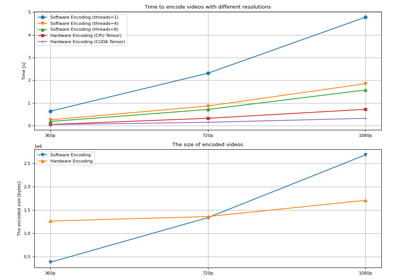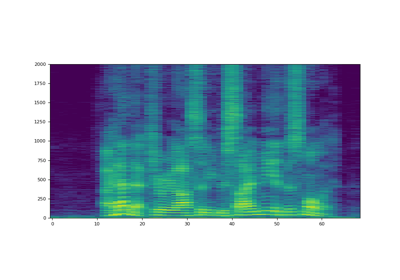ffmpeg_utils¶
用於更改 FFmpeg 庫(例如 libavformat)配置的模組。
它影響 torchaudio.io 中的功能(以及間接影響 torchaudio.load())。
clear_cuda_context_cache¶
get_audio_decoders¶
get_audio_encoders¶
- torchaudio.utils.ffmpeg_utils.get_audio_encoders() Dict[str, str][source]¶
獲取可用的音訊編碼器。
- 示例
>>> for k, v in get_audio_encoders().items(): >>> print(f"{k}: {v}") ... comfortnoise: RFC 3389 comfort noise generator ... s302m: SMPTE 302M ... aac: AAC (Advanced Audio Coding) ... ac3: ATSC A/52A (AC-3) ... ac3_fixed: ATSC A/52A (AC-3) ... alac: ALAC (Apple Lossless Audio Codec)
get_build_config¶
- torchaudio.utils.ffmpeg_utils.get_build_config() str[source]¶
獲取 FFmpeg 構建配置
- 返回值:
構建配置字串。
- 返回型別:
- 示例
>>> print(get_build_config()) --prefix=/Users/runner/miniforge3 --cc=arm64-apple-darwin20.0.0-clang --enable-gpl --enable-hardcoded-tables --enable-libfreetype --enable-libopenh264 --enable-neon --enable-libx264 --enable-libx265 --enable-libaom --enable-libsvtav1 --enable-libxml2 --enable-libvpx --enable-pic --enable-pthreads --enable-shared --disable-static --enable-version3 --enable-zlib --enable-libmp3lame --pkg-config=/Users/runner/miniforge3/conda-bld/ffmpeg_1646229390493/_build_env/bin/pkg-config --enable-cross-compile --arch=arm64 --target-os=darwin --cross-prefix=arm64-apple-darwin20.0.0- --host-cc=/Users/runner/miniforge3/conda-bld/ffmpeg_1646229390493/_build_env/bin/x86_64-apple-darwin13.4.0-clang # noqa
get_demuxers¶
get_input_devices¶
get_input_protocols¶
get_log_level¶
- torchaudio.utils.ffmpeg_utils.get_log_level() int[source]¶
獲取 FFmpeg 的日誌級別。
詳見
set_log_level()。
get_muxers¶
get_output_devices¶
get_output_protocols¶
get_versions¶
get_video_decoders¶
- torchaudio.utils.ffmpeg_utils.get_video_decoders() Dict[str, str][source]¶
獲取可用的影片解碼器。
- 示例
>>> for k, v in get_video_decoders().items(): >>> print(f"{k}: {v}") ... aasc: Autodesk RLE ... aic: Apple Intermediate Codec ... alias_pix: Alias/Wavefront PIX image ... agm: Amuse Graphics Movie ... amv: AMV Video ... anm: Deluxe Paint Animation
- 使用
get_video_decoders的教程
get_video_encoders¶
- torchaudio.utils.ffmpeg_utils.get_video_encoders() Dict[str, str][source]¶
獲取可用的影片編碼器。
- 示例
>>> for k, v in get_audio_encoders().items(): >>> print(f"{k}: {v}") ... a64multi: Multicolor charset for Commodore 64 ... a64multi5: Multicolor charset for Commodore 64, extended with 5th color (colram) ... alias_pix: Alias/Wavefront PIX image ... amv: AMV Video ... apng: APNG (Animated Portable Network Graphics) image ... asv1: ASUS V1 ... asv2: ASUS V2
- 使用
get_video_encoders的教程
set_log_level¶
- torchaudio.utils.ffmpeg_utils.set_log_level(level: int)[source]¶
設定 FFmpeg (libavformat 等) 的日誌級別
- 引數:
level (int) –
日誌級別。值越大,日誌越詳細。
以下是常用值、對應的
ffmpeg的-loglevel選項值和說明。-8(quiet):不列印任何輸出。0(panic):發生嚴重錯誤,程式即將崩潰。8(fatal):發生錯誤且無法恢復。例如,依賴頭部的格式未找到頭部,或使用了非法的引數組合。16(error):發生錯誤且無法無損恢復。但並非所有後續資料都會受到影響。24(warning):某些地方看起來不正確。這可能導致問題,也可能不會。32(info):標準資訊。40(verbose):詳細資訊。48(debug):僅對 libav* 開發者有用的資訊。56(trace):極其詳細的除錯資訊,對 libav* 開發有用。
- 使用
set_log_level的教程




